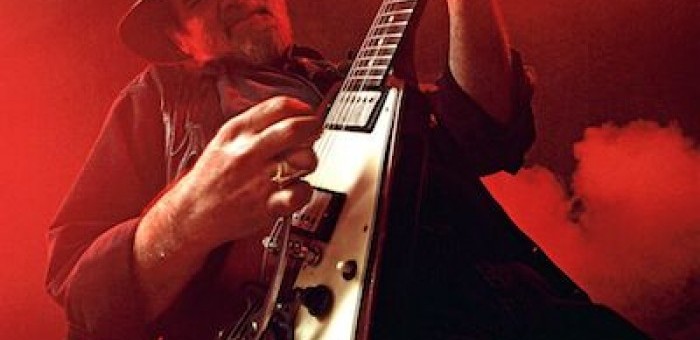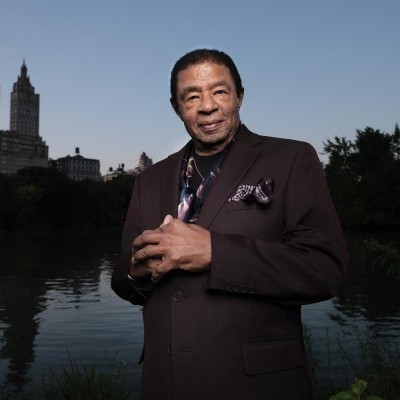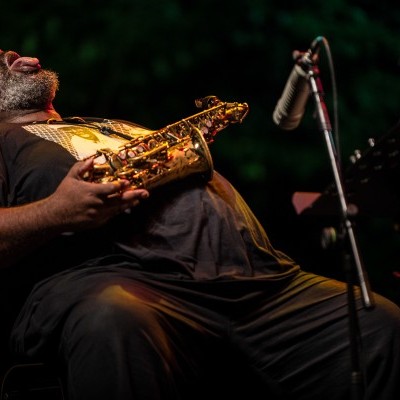Aug 26, 2025 1:53 PM
Blindfold Test: Buster Williams
Buster Williams, who at the age of 83 has been on the scene for 65 years, had never done a Blindfold Test. The first…

Lonnie Mack (1941–2016)
(Photo: Courtesy Alligator Records)Blues-rock guitarist and vocalist Lonnie Mack died on April 21 of natural causes at Centennial Medical Center near his home in Smithville, Tennessee. He was 74.
Heralded around the world for his early instrumental recordings, Mack explored blues, rock, country and other styles during his long, diverse career.
Mack’s early instrumental tracks, including the 1963 singles “Wham!” and “Memphis,” influenced many guitarists, such Eric Clapton, Duane Allman, Keith Richards, Jimmy Page and especially Stevie Ray Vaughan, who considered Mack a personal hero.
“Wham!” and “Memphis” were among the 11 tracks on the 1964 album The Wham Of That Memphis Man!, originally released on the Cincinnati label Fraternity Records, and then repeatedly reissued by various labels over the decades.
Mack also recorded for Elektra, Alligator, Epic and Capitol. While he was signed to Elektra, he contributed to the classic Doors album Morrison Hotel, released in 1970. Mack played bass guitar on the tracks “Roadhouse Blues” and “Maggie M’Gill.”
Mack’s 1985 release for Alligator, Strike Like Lightning, was coproduced by Vaughan, who also played on the album.
Mack died on the same day as singer-songwriter Prince (1958–2016). An April 21 tweet from blues superstar Joe Bonamassa nodded to the coincidence: “Lonnie Mack … Rest in Peace. Today has been a very bad day for music. Guitar players especially.”
Born Lonnie McIntosh on July 18, 1941, in Harrison, Indiana, he grew up 20 miles west of Cincinnati. As a child in rural Indiana, Mack fell in love with music. From family sing-alongs he developed a deep appreciation of country music, while also absorbing the r&b he heard on late-night radio as well as the gospel music that was sung at his local church.
Mack would later cite Merle Travis and Robert Ward (of the Ohio Untouchables) as his main guitar influences, and George Jones and Bobby “Blue” Bland as vocal inspirations.
He began playing professionally in his early teens (he quit school after a fight with his sixth-grade teacher), working clubs and roadhouses in Indiana, Kentucky and Ohio.
In 1958, Mack bought the guitar he would become best known for, a Gibson Flying V, serial number 7, which he equipped with a Bigsby tremolo bar. (The popularity of his single “Wham!” led to the tremolo bar being nicknamed a “whammy bar.”) In addition to his live gigs, Mack began playing sessions for the King and Fraternity labels in Cincinnati. He recorded with blues and r&b greats Hank Ballard, Freddie King and James Brown.
In 1963, at the end of another artist’s session, Mack cut an instrumental version of Chuck Berry’s tune “Memphis.” Unbeknownst to Mack, Fraternity released it as a single. Within a few weeks the single had climbed into the Top 5 on national charts. Mack went from being a talented regional player to a national star virtually overnight.
Mack was booked for hundreds of gigs a year, crisscrossing the country in his Cadillac and rushing back to Cincinnati or Nashville to cut new singles, including “Wham!,” “Where There’s A Will There’s A Way,” “Chicken Pickin’” and a dozen others. None of them sold as well as “Memphis,” but there was enough interest from fans and radio programmers to keep him on the road for another five years of one-nighters.
Fraternity Records went bust, but Mack kept on gigging, and in 1968 a Rolling Stone article stimulated new interest in his music. He signed with Elektra Records and cut three albums. Elektra also reissued his original Fraternity LP The Wham Of That Memphis Man!. Mack worked for a short time in the label’s A&R department.
He began playing all the major rock venues, from Fillmore East to Fillmore West. When Elektra merged with Warner Brothers, Mack grew disgusted with the new bureaucracy and walked out of his job.
He headed back to Indiana, where he played rural bars, went fishing and maintained a low profile. After six years of relative obscurity, he signed with Capitol and cut two albums that featured his country influences.
Mack played on the West Coast for a while and even flew to Japan for a “Save The Whales” benefit. Then he headed to New York City to team up with an old friend, Ed Labunski.
Labunski was a wealthy jingle writer who had grown tired of commercials and wanted to write and play for pleasure. He and Mack built a studio in Pennsylvania and spent three years organizing and recording a country-rock band called South, which included Buffalo-based keyboardist Stan Szelest, who later played on Mack’s Alligator debut.
Labunski and Mack had big plans for their partnership, including producing an album by a then-obscure Texas guitarist named Stevie Ray Vaughan. But the plans evaporated when Labunski died in an auto accident, and the South album was never commercially released.
Mack headed for Canada and joined the band of veteran rocker Ronnie Hawkins for a summer. After a brief stay in Florida, he returned to Indiana in 1982, playing clubs in Cincinnati and the surrounding area.
Mack began his comeback on the national scene in November 1983. At Vaughan’s urging, he relocated from Indiana to Texas, where he settled in Spicewood. He began jamming with Vaughan (who proudly proclaimed that “Wham!” was the first 45 r.p.m. single he ever owned). Mack played in local clubs and flew to New York for gigs at the Lone Star and the Ritz.
When Alligator Records approached Mack to do an album, Vaughan immediately volunteered to help out. The result was 1985’s Strike Like Lightning.
Mack’s re-emergence was a major music industry event that generated plenty of media attention. Vaughan, Keith Richards, Ron Wood and Ry Cooder all joined Mack onstage during his 1985 tour.
A review in The New York Times stated, “Although Mr. Mack can play every finger-twisting blues guitar lick, he doesn’t show off; he comes up with sustained melodies and uses fast licks only at an emotional peak. Mr. Mack is also a thoroughly convincing singer.”
The tour to promote Strike Like Lightning drew attention from all corners of the music world. Bob Dylan, Mick Jagger, Paul Simon, Eddie Van Halen and Dwight Yoakam all attended shows. The year was capped off with a stellar performance at New York’s prestigious Carnegie Hall with blues icons Albert Collins and Roy Buchanan. That show was chronicled on the DVD as Further On Down The Road.
Mack recorded two more albums for Alligator, Second Sight (1986) and Live! Attack Of the Killer V (1990). In between he signed with Epic Records and released Roadhouses And Dancehalls in 1988.
Mack continued to tour into the 2000s. He relocated to Smithville, Tennessee, where he continued writing songs but ceased active touring.
In 2001 he was inducted into the International Guitar Hall Of Fame, and in 2005 into the Rockabilly Hall Of Fame.
Survivors include five children and several grandchildren and great-grandchildren.
Funeral arrangements are pending.
To read more about Mack, visit the Alligator Records website.

“What I got from Percy was the dignity of playing the bass,” Buster Williams said of Percy Heath.
Aug 26, 2025 1:53 PM
Buster Williams, who at the age of 83 has been on the scene for 65 years, had never done a Blindfold Test. The first…

Don and Maureen Sickler serve as the keepers of engineer Rudy Van Gelder’s flame at Van Gelder Studio, perhaps the most famous recording studio in jazz history.
Sep 3, 2025 12:02 PM
On the last Sunday of 2024, in the control room of Van Gelder Studio, Don and Maureen Sickler, co-owners since Rudy Van…

The Free Slave, Cosmos Nucleus and Sunset To Dawn: three classic Muse albums being reissued this fall by Timer Traveler Recordings.
Aug 26, 2025 1:32 PM
Record producer and “Jazz Detective” Zev Feldman has launched his next endeavor, the archival label Time Traveler…

Butcher Brown, clockwise from top left: Marcus Tenney, DJ Harrison, Morgan Burrs, Corey Fonville and Andrew Randazzo. (Keyboardist Harrison couldn’t make the gig, so special guest Jacob Mann sat in with the band at the Reno Jazz Festival.)
Aug 19, 2025 12:41 PM
The band known as Butcher Brown has enjoyed the last half-decade basking in the glow from the twin engines of critical…

This year’s Jazz em Agosto set by the Darius Jones Trio captured the titular alto saxophonist at his most ferocious.
Aug 26, 2025 1:31 PM
The organizers of Lisbon, Portugal’s Jazz em Agosto Festival assume its audience is thoughtful and independent. Over…